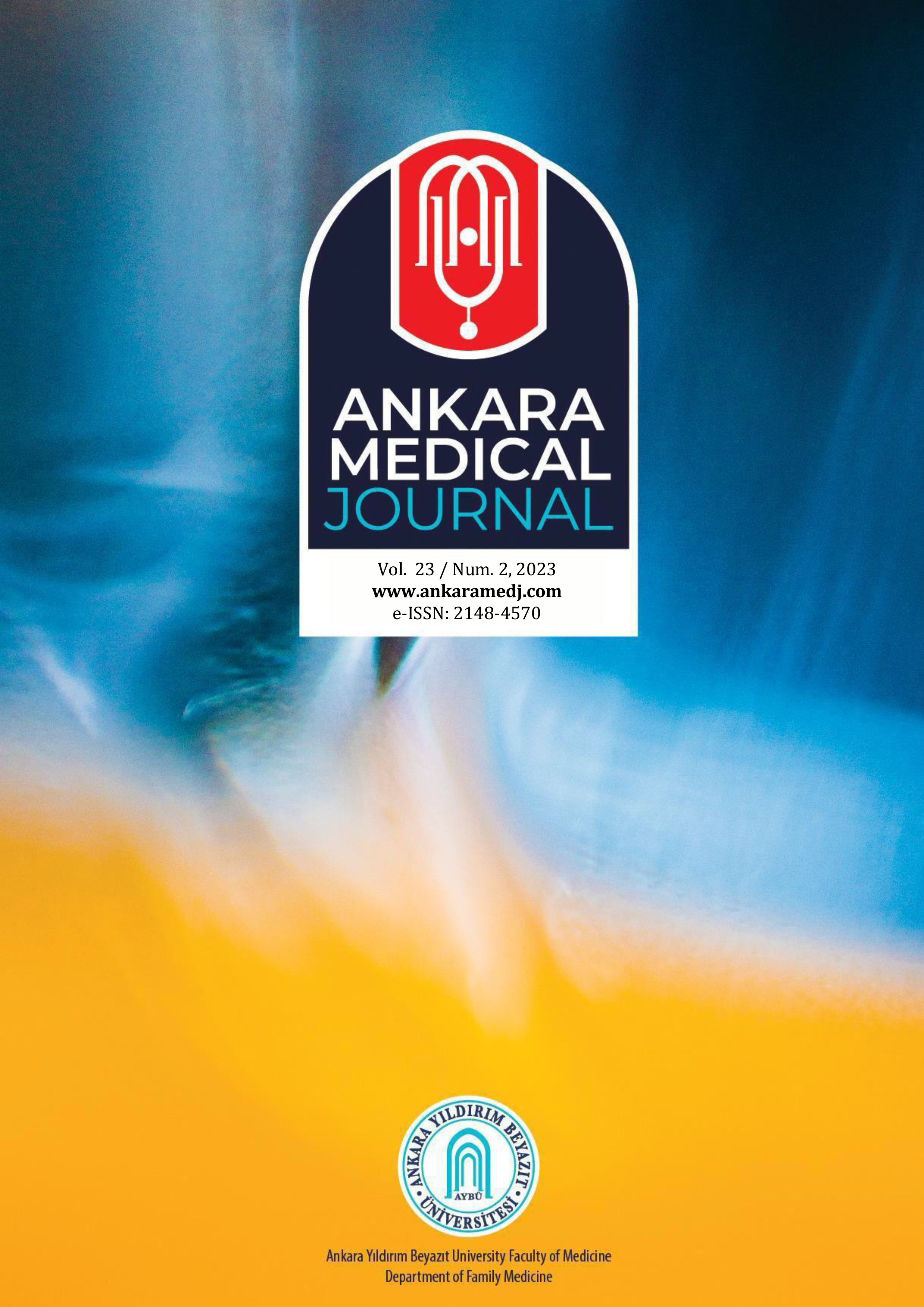E-ISSN: 2148-4570 ISSN:2148-4570
Volume: 23 Issue: 2 - 2023
| ORIGINAL ARTICLE | |
| 1. | The Change of the Vitamin D Test Request Number after the Regulation by the Ministry of Health Mustafa Mahir Ulgu, Naim Ata, Derun Taner Ertugrul, Murat Çağlayan, Mustafa Okan Ayvali, Osman Celik, Suayip Birinci, Muhammed Kizilgul doi: 10.5505/amj.2023.45712 Pages 165 - 175 INTRODUCTION: There has been an increase in 25-hydroxy vitamin D (25(OH)D) test requests and laboratory costs in recent years. At the end of 2019, the General Directorate of Health Information Systems issued a regulation calling for restricting vitamin D requests in primary care. We aimed to investigate the effect of this regulation on the requested numbers of 25(OH)D tests with the big data obtained from the national information health system of the Turkish Ministry of Health. METHODS: Between 2016-2022, all inpatient and outpatient tests and 25(OH)D tests in all medical biochemistry laboratories in Turkey were determined based on department and institution type. Distribution among health institutions and test request rates were calculated. RESULTS: The total number of 25(OH)D tests requested was increased from 2016 to 2022, except for 2020 and 2021, probably related to the COVID-19 pandemic. The yearly increase rate in 2017, 2018, 2019, and 2022 was 137%, 56%, 16%, and 5%, respectively. The number of 25(OH)D tests requested in primary care institutions decreased after the regulation. The total number of 25(OH)D tests requested in 2nd and 3rd Stage Public Health Facilities and private hospitals increased in 2022 compared to 2019. DISCUSSION AND CONCLUSION: Our findings showed that the request for 25(OH)D testing decreased in primary care and increased in 2nd and 3rd Stage Public Health Facilities and private hospitals after the regulation was released. Despite the decrease in the yearly increase rate in the number of test requests, the annual number of tests requested is still high, suggesting that different measures should be taken. |
| 2. | Evaluation of Malnutrition in Geriatric Patients Receiving Home Care Services Nur Şimşek Yurt, Mahcube Çubukçu doi: 10.5505/amj.2023.88557 Pages 176 - 186 INTRODUCTION: In our study, it was aimed to determine the frequency of malnutrition and assess risk factors related to malnutrition in elder individuals receiving home care services. METHODS: This cross-sectional, descriptive study was conducted on patients who were registered to Home Care Services of Samsun Training and Research Hospital. All patients assessed sociodemographic characteristics, comorbid diseases, level of dependence, presence of pressure sore, use of nutrition supplement and nutritional status were assessed by Mini Nutritional Assessment-Short Form (MNA-SF) using face-to-face interview method. RESULTS: Overall, the study included 356 subjects (218 female, 61.24%). The mean age was 79.31±8.60 years. Of the subjects, 42.14% (n=150) were in the age group of 75-84 years. The mean MNA-SF score was 9.20±2.85. Based on the MNA-SF score, 27.52% (n=98) of the subjects had malnutrition, while 42.69% had a risk of malnutrition. The MNA-SF score was significantly lower in males (p=0.009), in those aged ≥85 years (p=0.035), in those with oncological disease (p=0.002), in those with cerebrovascular disease (p=0.003), in those with dementia (p<0.001), in the presence of pressure sore (p<0.001) and in bedridden (p<0.001). In the logistic regression analysis, it was found that being gender (p=0.002), bedridden (p<0.001), oncologic disease (p<0.001), cerebrovascular disease (p=0.002), dementia (p<0.001) and presence of pressure sore (p=0.002) were independent risk factors for malnutrition. DISCUSSION AND CONCLUSION: The risk of malnutrition was increased in male gender, in patients aged≥85 years and in those with cerebrovascular disease and dementia. The malnutrition prevalence was found to be high in patients with oncologic disease, in the presence of pressure sore and in bedridden patients. |
| 3. | Screening of Cardiovascular Risks in Active Athletes within the Provincial Directorate of Youth and Sports Hasan Sakallı, Celal Kus, Raziye Şule Gümüştakim, Duygu Ayhan Baser, Ahmet Cagri Aykan, Selçuk Akturan doi: 10.5505/amj.2023.37980 Pages 187 - 200 INTRODUCTION: This study aimed to assess the cardiovascular risks of athletes engaged in sports activities in various branches. METHODS: In this cross-sectional study, a 20-item questionnaire including demographic information and sports history was applied to 181 athletes. In addition to physical examinations, complete blood count, biochemistry, lipid profile, TSH, T4, ECG and ECHO tests were conducted. RESULTS: Of the athletes, 25 (13.81%) had a pathology that could impede them from doing sports was detected. When the data was examined by comparing participants with and without the pathological status, statistically significant differences were found in terms of cardiac rate, the presence of ventricular hypertrophy, T-wave, deviation in cardiac axis, HDL, LDL, calcium, ALT, diastolic blood pressure and the frequency of training per week. DISCUSSION AND CONCLUSION: The presence of conditions posing any health risk among actively engaged athletes suggests that some risky situations can be overlooked in the examinations necessary for entry into sports. Family physicians should take a full anamnesis when evaluating people who want to do sports, and accordingly carry out a detailed examination, and predicate their findings on laboratory findings. |
| 4. | Are Pituitary Functions Different in Obese Patients According to Body Mass Index Classes? Neslihan Çuhacı Seyrek doi: 10.5505/amj.2023.26096 Pages 201 - 209 INTRODUCTION: In this study, we aimed to evaluate whether there is a difference in the pituitary functions in obese patients according to the different body mass index (BMI) classes METHODS: We retrospectively evaluated 192 patients with obesity. According to the obesity degree, patients were divided into class I (BMI;30.0-34.9 kg/m2), class II (BMI; 35.0-39.9 kg/m2) or class III (BMI; ≥40 kg/m2) obesity. The demographic data of the patients (sex, age), thyroid function tests, estrogen (E2), follicle-stimulating hormone (FSH), luteinizing hormone (LH), growth hormone (GH), insulin-like growth factor-I (IGF-I), total and free testosterone, cortisol, adrenocorticotrophic hormone (ACTH) levels were measured. Also, 24-hour urine-free cortisol levels and a 1 mg dexamethasone suppression test were performed. RESULTS: Total of the 192 patients, 44 (22.92%) were male, 148 (77.08%) were female. According to BMI classes, 12 (6.25%) patients were in class I, 38 (19.79%) patients were in class II and 142 (73.96%) patients were in class III obesity. No significant difference was found between the groups in hormonal parameters except the IGF-I level. 1 mg dexamethasone suppression test was suppressed in all patients. DISCUSSION AND CONCLUSION: In our study, we found that there was no difference in pituitary functions according to obesity classes, except for the IGF-I level. Further studies are needed to investigate these functions in different classes of obesity. |
| 5. | Confronting the Dual Challenge: The Impact of the Covid-19 Pandemic on the Management of Acute Coronary Syndromes in a Leading Tertiary Hospital in Turkey Esma Çetinkaya, Harun Kundi, Abdullah Nabi Aslan, Murat Akçay doi: 10.5505/amj.2023.25665 Pages 210 - 221 INTRODUCTION: In this study, we aimed to determine the impact of the SARS-CoV-2 pandemic (COVID-19) on the number, morbidity and mortality of acute myocardial infarction patients in Ankara Bilkent City Hospital, which has the largest patient capacity in the European region. METHODS: A total of 1173 patients who were hospitalized with the diagnosis of acute myocardial infarction in Ankara Bilkent City Hospital between December 2019 to July 2020 were included in this study. These patients were divided into two groups according to the admission date. In this study, in light of the measures taken with the onset of the COVID-19 pandemic in Turkey, the effect of the pandemic on hospital admissions, application types, number of patients, laboratory, echocardiography, and angiography parameters of patients diagnosed with acute myocardial infarction (AMI) was investigated. RESULTS: The month with the highest number of patients admitted to the emergency department was December, and the month with the lowest number was April. Compared to pre-COVID-19, an approximately 19% decrease was observed in hospital admissions after COVID-19. Also, medical treatment was more common than revascularization after the pandemic (73.43% vs. 26.56%, respectively, p <0.001). The frequency of non-culprit lesion intervention was significantly decreased after the COVID-19 pandemic compared to the time before the pandemic. (39.24% vs 60.75%, respectively, p= 0.002). DISCUSSION AND CONCLUSION: Coronavirus-19 pandemic reduced not only the admission of AMI patients to hospitals but also the frequency of revascularization and intervention in the non-culprit artery before discharge. All of these factors led to low ejection fraction and high troponin values in these patients. |
| 6. | A Scoring Index For Predicting Thyroid Malignancies Neslihan Çuhacı Seyrek, Berna Evranos Ogmen, Abbas Ali Tam, Didem Ozdemir, Oya Topaloglu, Aylin Yazgan, Ersin Gurkan Dumlu, Reyhan Ersoy, Bekir Cakir doi: 10.5505/amj.2023.88614 Pages 222 - 234 INTRODUCTION: We evaluated ultrasonography (US) features of thyroid nodules ≤ 1 cm and > 1 cm and determined the features that might predict malignancy, also aimed to develop a new scoring system considering US features to avoid unnecessary fine-needle aspiration biopsy (FNAB), particularly for subcentimeter nodules. METHODS: We retrospectively evaluated 2233 nodules of 1118 patients who underwent thyroidectomy. US features predictive for malignant histopathology were evaluated by multivariate logistic regression analysis. A US index score was calculated for each nodule considering these features. RESULTS: 337 (15.11%) nodules were ≤1 cm, and 1896 (84.89%) were > 1 cm. In total, 173 (51.33%) of the ≤1 cm nodules were histopathologically benign, and 164 (48.67%) were malignant. Anteroposterior/transverse diameter (AP/T) ≥1, microcalcifications, macrocalcifications, and hypoechoic patterns were significantly more frequent in ≤1 cm malignant compared with benign nodules. Microcalcification, macrocalcification, hypoechoic and iso-hypoechoic patterns, and solid texture were significantly higher in the malignant than the benign group in > 1 cm nodules. The best cut-off of US index scores for discrimination of benign and malignant nodules were > 2 and > 4 for ≤1 cm and > 1 cm nodules, respectively. DISCUSSION AND CONCLUSION: Our US scoring system may help clinicians and surgeons to select nodules for FNAB more accurately, particularly those sub-centimeter in size. |
| CASE REPORT | |
| 7. | A Case Report of Acute Appendicitis Presenting with Diarrhea Seyma Handan Akyon, Rabia Kipel, İrfan Şencan doi: 10.5505/amj.2023.77853 Pages 235 - 240 A 26-year-old female patient presented to the family medicine outpatient clinic with complaints of diarrhea, widespread abdominal pain, nausea, and vomiting, which had been going on for five days. In the first physical examination findings of the patient, there was widespread sensitivity in the abdomen, but there were no findings of defense or rebound. The patient was re-evaluated with the results of conducted tests, her abdominal examination was repeated, and rebound positivity was detected in the right lower quadrant. The patient was referred to the Emergency Department, and she was taken into operation by the general surgery team with the diagnosis of acute appendicitis. The most important factor in delaying the diagnosis of acute appendicitis is the presence of gastroenteritis. Cases of acute appendicitis presenting with diarrhea have been reported in the medical literature. Since acute pathologies should always be kept in mind in the differential diagnosis of patients who present to primary care with abdominal pain and diarrhea, it is deemed appropriate to present the case with literature. |
| REVIEW | |
| 8. | From Trauma to Post-Traumatic Stress Disorder: Identification of the Risk Factors Esra Kabadayı Şahin, Fatma Sevil doi: 10.5505/amj.2023.90699 Pages 241 - 255 People encounter various traumatic events throughout their lives. However, most people can cope with these stressful life events in different ways without experiencing any long-term mental problems. Post-Traumatic Stress Disorder (PTSD) is a chronic and important psychiatric disorder that develops in a small number of people as a result of short or long-term exposure to one or more traumatic events and affects the life of an individual. For this reason, it is important to identify people at risk for the development of PTSD and to apply appropriate intervention methods for these people to prevent the disability caused by PTSD. In this review article, the factors that lead to the risk of developing PTSD in individuals exposed to trauma are discussed in light of current information in the literature. |






